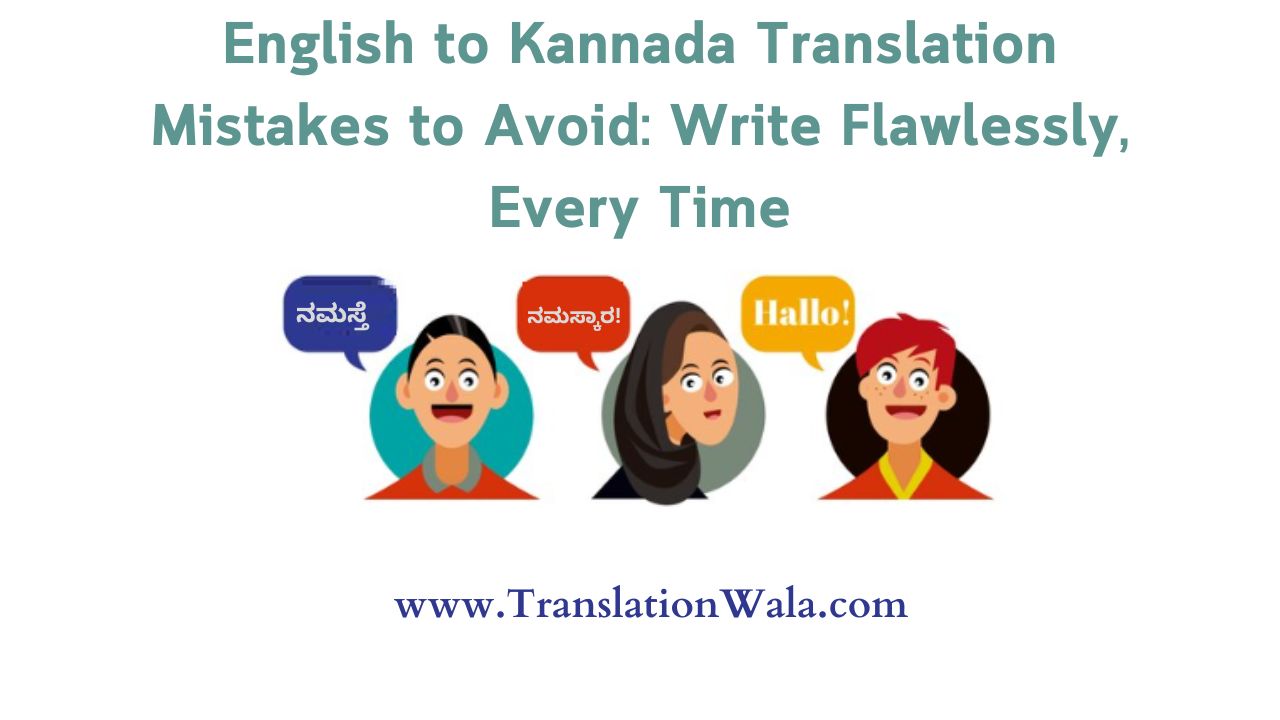English to Kannada Translation: Languages are like a beautiful fabric that can bring people together and make our lives better. Still, it can be hard to figure out how to translate, especially when the languages are so different, like English and Kannada. Even though translation tools are helpful, you need to be aware of typical mistakes when learning Kannada to make sure your communication is clear and accurate.
This piece goes over the five biggest mistakes you should never make when English to Kannada Translation. By doing so, you’ll be able to write perfectly every time:
False Cognates and Semantic Equivalents:
When two languages have words that look alike but mean different things, these are called fake cognates. For example, the English word “present” might mean “ಉಡುಗರೆ” (clothes) in Kannada, while the word “introduce” might mean “ಪರಿಚಯಿಸು” (introduce). In the same way, conceptual equivalents—words that mean similar but not the same—can also cause confusion. If you translate “hope” as “ಆಶಯ” (desire) instead of “ನಂಬಿಕೆ” (hope), the meaning of the line might change.
Tip: Use a language dictionary that gives readings based on the situation, and pay close attention to word roots and origins to stay clear.
Read More: The Beauty of Bengali Unveiled: English to Bengali Translation for Literary Appreciation
Grammatical Misinterpretations:
English and Kannada have different ways of putting together sentences. Kannada uses agglutinative grammar, which changes verbs and words with endings. English uses a lot of prepositions. If you translate “The book is on the table” directly as “ಮೇಜಿನ ಮೇಲೆ ಪುಸ್ತಕ” (book on table),” which leaves out the subject (“is”) and changes the way the sentence is put together.
Tip: Learn the basic rules of Kannada language, especially how to change the form of verbs and nouns, so that your versions are right.
Cultural Nuances and Idioms:
Idioms make language even more interesting and complicated because they are deeply connected to society. If you directly translate English sentences like “kick the bucket” or “break a leg” into Kannada, you might get silly words and phrases like “ಬಕೆಟ್ ಅನ್ನು ಒದೆಯಿರಿ” or “ಕಾಲು ಮುರಿಯಿರಿ”. In the same way, cultural terms like “raining cats and dogs” might not make sense in Kannada.
Tip: Find out what other languages say that English idioms and proverbs mean so that you can keep the meaning and avoid exact versions that lose the point.
False Friends and Homophones:
Words that sound or look alike but have different meanings are called false friends. People may get the wrong idea if you translate “fair” as “ನ್ಯಾಯಸಮ್ಮತ” (just) instead of “ನೀತಿಬೋಧೆ” (fair). Homophones, which are words that sound the same but mean different things, can also be confusing. Sometimes “right” can mean “ಸರಿಯಾದ” (correct) and other times it can mean “ಬಲ” (right side).
Tip: To correctly figure out fake friends and homophones, use background clues and books with sound guides.
Read More: The Role of Technology in English to Gujarati Translation: Streamlining the Process
Overreliance on Machine Translation:
Translation tools can help right away, but they often have trouble with subtleties, cultural references, and the bigger picture. If you depend on machine versions without question, they might get things wrong, especially if the text is complicated or technical.
Tip: While translation tools can help, the final product should always be reviewed and edited by hand to make sure it is correct and flows naturally in Kannada.
Beyond Avoiding Mistakes:
To become a master English to Kannada Translation, you need to do more than just avoid making mistakes. If you want to really write perfectly, think about these other suggestions:
- Immerse yourself in Kannada: You can learn more about the language and its culture by watching movies, listening to music, and reading books written in Kannada.
- Consult native speakers: Talk to people who speak Kannada to learn about idioms, cultural differences, and the natural flow of the language.
- Practice consistently: The more you interpret, the better you understand the differences between the two speech patterns. Don’t be afraid to try new things and get better.
Conclusion:
English to Kannada Translation, you need to pay close attention to details, understand other cultures, and be willing to keep learning. You can communicate perfectly and connect with people from other countries if you avoid making common mistakes and enjoy the subtleties of both languages. So, start this trip that will improve you, be ready for difficulties, and write one word at a time until you learn Kannada.
